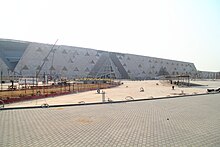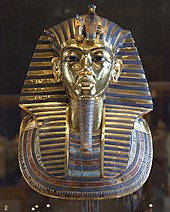|
Grand Egyptian Museum
The Grand Egyptian Museum (GEM; Arabic: المتحف المصرى الكبير al-Matḥaf al-Maṣriyy al-Kabīr), also known as the Giza Museum, is an archaeological museum under construction in Giza, Egypt, about 2 kilometres (1.2 miles) from the Giza pyramid complex. The Museum will host over 100,000 artifacts from ancient Egyptian civilization, including the complete Tutankhamun collection, and many pieces will be displayed for the first time.[4] With 81,000 m2 (872,000 sq ft) of floor space, it will be the world's largest archeological museum.[5] It is being built as part of a new master plan for the Giza Plateau, known as "Giza 2030". The GEM will also host permanent exhibition galleries, temporary exhibitions, special exhibitions, children museum, and virtual and large format screens with a total floor area of 32,000 m2. The museum was built by a joint venture of the Belgian BESIX Group and the Egyptian Orascom Construction.[6] The original estimated completion date was 2013, and past estimates of the opening date have varied. As of 16 October, 2024 the Grand Hall, Grand Staircase, commercial area, 12 public galleries and the exterior gardens are open for tours, while the Tutankhamun gallery and Solar Boat Museum are not yet open to the public.[7] OverviewThe building design was decided by an architectural competition[8] announced on 7 January 2002. The organisers received 1,557 entries from 82 countries, making it the second largest architectural competition in history. In the second stage of the competition, 20 entries submitted additional information on their designs. Judging was complete by 2 June 2003. The competition was won by architects Róisín Heneghan and Shi-Fu Peng, and their company Heneghan Peng Architects of Ireland; the awarded prize was US$250,000.[9] The building was designed by Heneghan Peng Architects, Buro Happold, Arup and ACE Consulting Engineers (Moharram and Bakhoum). The landscape and site masterplan was designed by West 8; the exhibition masterplan, exhibition design, and museology was led by Atelier Brückner.[10] On 2 February 2010, Hill International announced that Egypt's Ministry of Culture had signed a contract with a joint venture of Hill and EHAF Consulting Engineers to provide project management services during the design and construction of the Grand Egyptian Museum.[11]  The building is shaped like a chamfered triangle in plan. It sits on a site 2 kilometres (1.2 miles) northwest of the pyramids, near a motorway interchange. The building's north and south walls line up directly with the Great Pyramid of Khufu and the Pyramid of Menkaure. The front of the museum includes a large plaza filled with date palms and a façade made of translucent alabaster stone. Inside the main entrance is a large atrium, where large statues will be exhibited. The project is estimated to cost US$550 million, of which US$300 million will be financed from Japanese loans. The remaining costs are financed by the Supreme Council of Antiquities, other donations, and international funds. The new museum is designed to include newer technologies, such as virtual reality. The museum will also be an international center of communication between museums, to promote direct contact with other local and international museums. The Grand Egyptian Museum will include a children's museum, conference center, training center, and workshops designed similarly to the old Pharaonic places. History On 5 January 2002, then-Egyptian President Hosni Mubarak laid the foundation stone of the Grand Egyptian Museum. In 2006, the 3,200 years old Statue of Ramesses II was relocated from Ramses Square in Cairo to the Grand Egyptian Museum site, near that Giza Plateau. It was moved to the atrium of the museum in January 2018.[12][13] In 2007, GEM secured a $300 million loan from the Japan Bank for International Cooperation. The Egyptian Government will fund $147 million while the remaining $150 million will be funded through donations and international organisations.[14] In late August 2008, the design team submitted over 5,000 drawings to the Egyptian Ministry of Culture. Following this, the construction tender was announced in October 2008. Earthmoving has begun to excavate the site for the building. Tendering was due in September 2009, with an estimated completion date of 2013.[15] On 11 January 2012, a joint venture between Egypt's Orascom Construction (OC) and the Belgian BESIX was awarded the contract for phase three of the Grand Egyptian Museum (GEM), a deal valued at $810 million.  In January 2018, Besix and Orascom brought in and installed an 82-ton, 3,200-year-old statue of Ramses II in the Grand Egyptian Museum. It was the first artefact to be installed in the Museum, during construction, due to its size.[16][17] On 29 April 2018, a fire broke out near the entrance of the GEM but artifacts were not damaged and the cause of the fire was unknown.[18] In May 2018, the last of King Tutankhamun's chariots was moved to GEM.[19] In November 2018, the estimate for a full opening was pushed back to last quarter of 2020, according to Tarek Tawfik, GEM's director.[20] In April 2020, the planned opening of the museum was pushed to 2021 due to the COVID-19 pandemic.[21] Various subsequent estimates ranged from 2020 to 2023.[22][23][24][25][26][27][excessive citations] In August 2020, two colossal statues discovered in the sunken city of Thonis-Heracleion by the IEASM[28] were set up in the entrance hall of the GEM.[29] The Grand Egyptian Museum (GEM) began limited public access in February 2023, allowing visitors to explore the main entrance hall and commercial areas[30]. In May 2024, Gihane Zaki was appointed as the head of the museum[31], and it was announced that the official opening was scheduled for "later this year"[32]. However, there has been no official announcement of a definitive opening date. On October 16, 2024, the museum expanded its offerings by opening twelve main galleries as part of a trial run. These galleries showcase artifacts from various periods of ancient Egyptian history, with daily attendance capped at 4,000 visitors[33]. Despite these significant developments, the full official opening—featuring the complete display of the Tutankhamun collection and the solar boats—remains pending. The GEM is available for private tours in advance of its official opening.[34] Logo designOn 10 June 2018, the museum's logo was revealed, which will be used in the museum's promotional campaign in Egypt and the world. The logo was designed by Tariq Atrissi.[35] The cost of the design amounted to 800,000 Egyptian pounds, which included the costs of designing the museum exhibition implemented by the German company "Atelier Bruckner".[36] Exhibits The exhibits cover about one-third of the total museum's 50-hectare grounds displaying over 13,000 artefacts in 12 galleries arranged by time period (c.3100BCE~400CE) and theme (Society/Kingship/Beliefs) from the museum's total collections of 50,000 objects. The artefacts were relocated from storage and museums in Cairo, Luxor, Minya, Sohag, Assiut, Beni Suef, Fayoum, the Delta, and Alexandria.[37][38] The official opening expected to occur later in 2024 will feature the first exhibition of about 5,000 objects of King Tutankhamun's full tomb relocated from the Egyptian Museum in Cairo and the reconstructed (August 2021) Khufu ship, a solar barque, that was relocated to the GEM from the Giza Solar boat museum beside the Great Pyramid.[39] See alsoReferences
External links |
||||||||||||||||||||||||||||||||||||||||||||||



